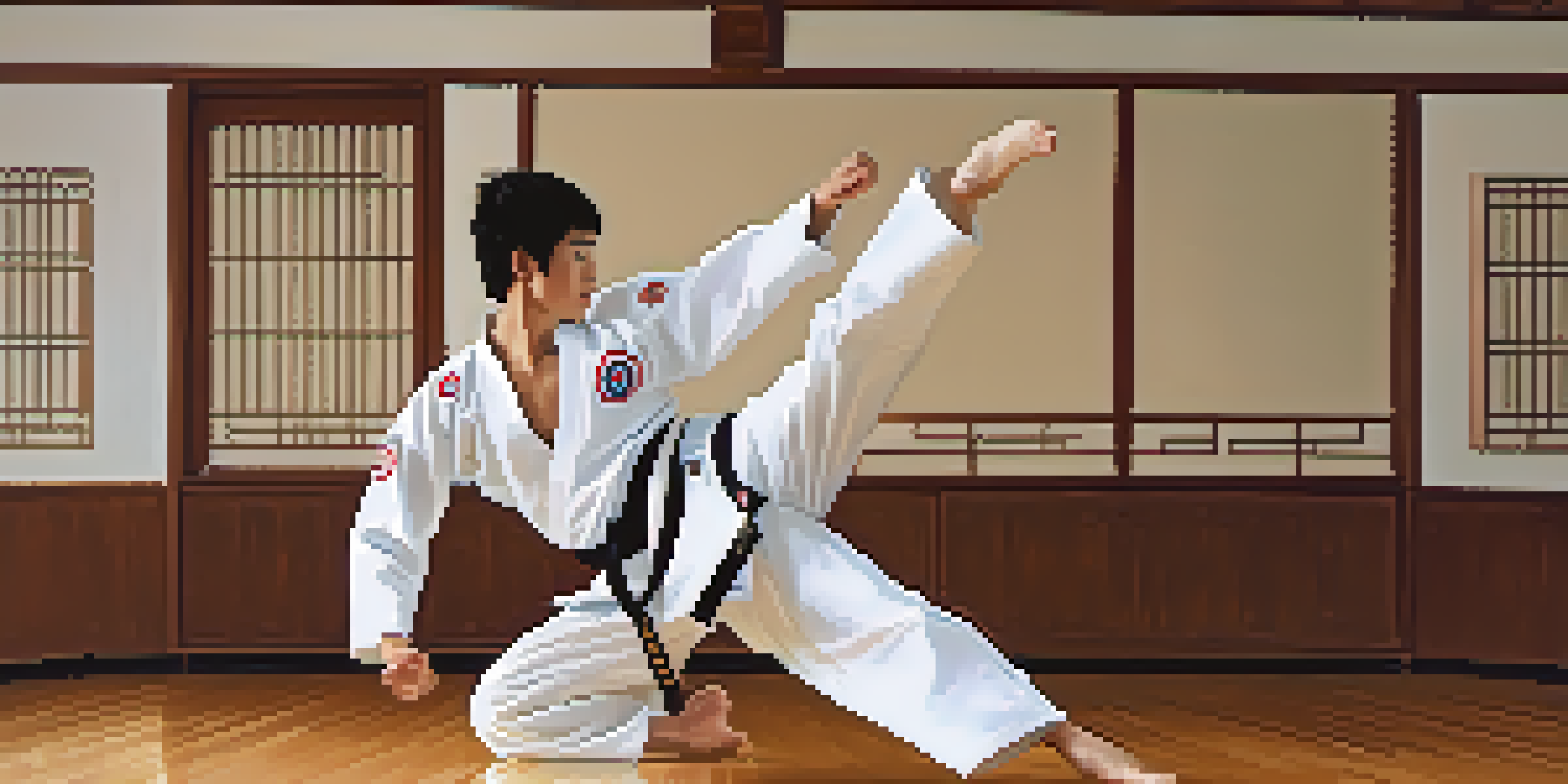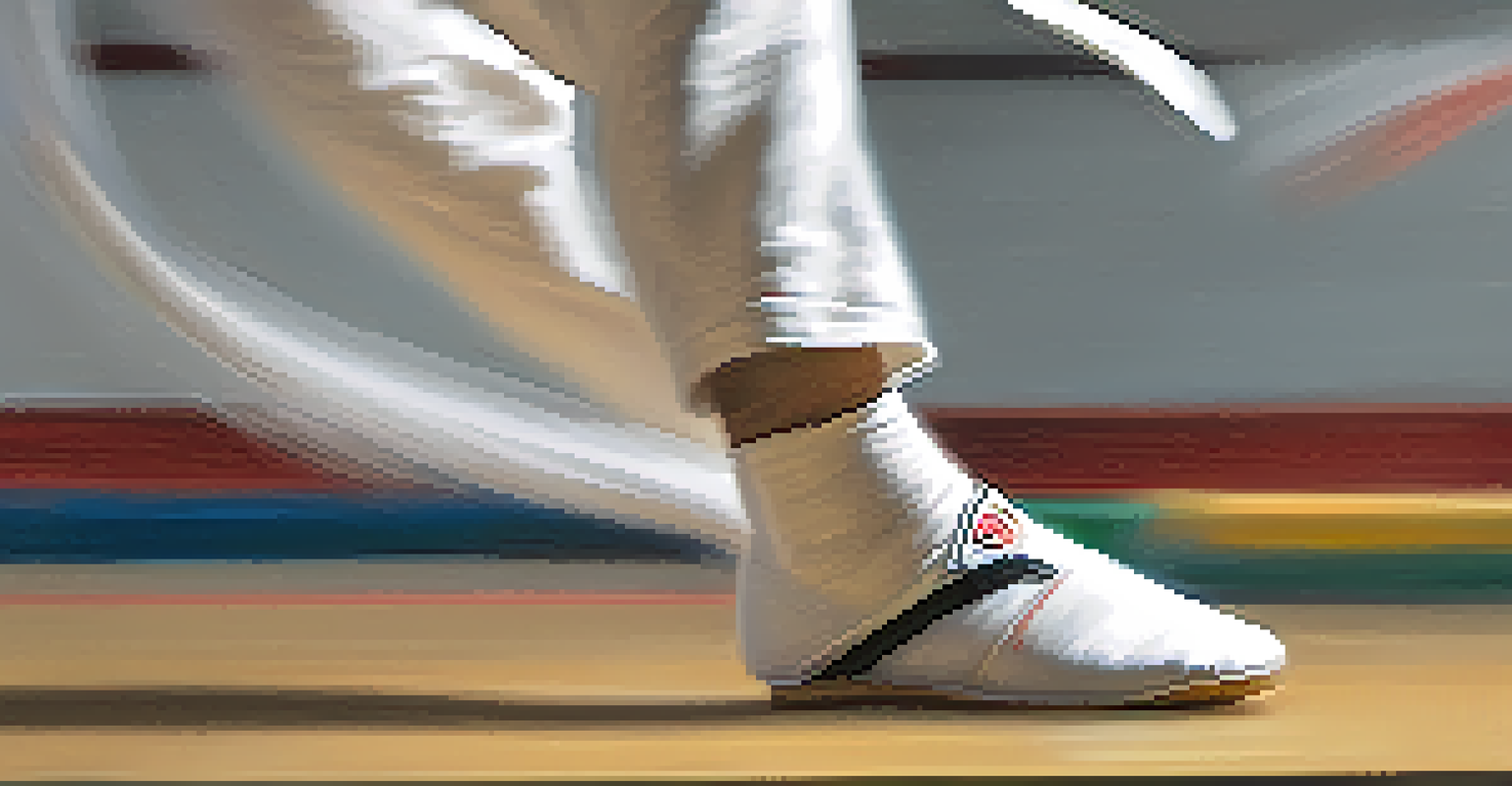Taekwondo Kicks: Mastering the Art of Dynamic Kicking Styles

Understanding the Importance of Kicks in Taekwondo
Kicks are the backbone of Taekwondo, showcasing both power and precision. They not only allow practitioners to defend themselves but also serve as a means of expressing art through movement. Each kick is designed to target specific areas, providing a strategic advantage in sparring and self-defense.
The more I practice, the luckier I get.
Moreover, mastering these kicks enhances overall physical fitness, flexibility, and balance. Think of it like learning to play a musical instrument; each kick is a note that contributes to a beautiful symphony of martial arts. As you practice, you develop rhythm, coordination, and grace.
In essence, kicks are more than just techniques; they are a vital part of a Taekwondo practitioner's journey, intertwining discipline, creativity, and athleticism. By focusing on kicks, you can elevate your skills and deepen your appreciation for this dynamic martial art.
The Front Kick: A Fundamental Taekwondo Technique
The front kick, or 'Ap Chagi,' is one of the most fundamental kicks in Taekwondo. It's often the first kick taught to beginners due to its simplicity and effectiveness. Picture a powerful jab in boxing; it’s straightforward yet can be incredibly impactful when executed correctly.

This kick primarily targets the opponent’s midsection or face, making it versatile for both offensive and defensive strategies. To perform a front kick, you lift your knee, extend your foot forward, and strike with the ball of your foot. It’s all about technique and timing—practice makes perfect!
Kicks Are Essential in Taekwondo
Kicks not only enhance self-defense but also embody the artistry and discipline of Taekwondo.
As you become more comfortable with the front kick, you can experiment with variations and combinations. This foundational kick sets the stage for more complex techniques, reinforcing the idea that mastering the basics is essential for growth in Taekwondo.
Roundhouse Kick: The Art of Precision and Power
The roundhouse kick, known as 'Dollyo Chagi,' is a staple in Taekwondo that emphasizes speed and precision. Imagine swinging a baseball bat; it requires proper positioning and timing to hit the ball effectively. Similarly, this kick involves a swift motion that targets an opponent's head or body with the instep or shin.
Success is where preparation and opportunity meet.
To execute a roundhouse kick, pivot on your supporting foot while bringing your knee up and extending your leg in a sweeping motion. This movement combines balance and agility, allowing for a powerful strike. Practicing this kick helps develop hip flexibility and overall coordination.
As you refine your roundhouse kick, you'll find it becomes a key part of your sparring strategy. Its versatility allows you to surprise opponents, making it an essential component of a Taekwondo practitioner’s toolkit.
Side Kick: Harnessing the Power of Momentum
The side kick, or 'Yeop Chagi,' is a powerful technique that utilizes the body's momentum to deliver a strong strike. Think of it like a door swinging open; the force comes from the pivot and release. This kick is especially effective for targeting the ribs or knees of an opponent.
To perform a side kick, you lift your knee to the side, extend your leg, and strike with the heel or edge of your foot. This requires not only strength but also precise balance and control. As you practice, you'll learn to harness your body’s weight to create maximum impact.
Mastering Basic Kicks is Crucial
Fundamental kicks like the front kick set the foundation for more advanced techniques and overall skill development.
Mastering the side kick can significantly enhance your sparring effectiveness. Its ability to create distance and deter an opponent makes it a valuable tool in both competition and self-defense scenarios.
Back Kick: A Sneaky Surprise for Your Opponent
The back kick, or 'Dwi Chagi,' is a unique and effective technique that can catch your opponent off guard. Imagine a surprise twist in a movie; it’s unexpected yet powerful. This kick allows you to strike behind you without losing sight of your opponent, making it a valuable skill in Taekwondo.
To execute a back kick, you first turn away from your opponent, then thrust your heel backward while extending your leg. This requires a strong core and good spatial awareness, as you need to anticipate your opponent’s movements. Practicing this kick can significantly improve your agility and reaction time.
In sparring, the back kick can serve as an excellent counterattack, especially when your opponent is closing in. Its effectiveness lies in its surprise element, demonstrating that sometimes the best offense is an unexpected defense.
Hook Kick: Adding Flair to Your Kicking Arsenal
The hook kick, or 'Huryeo Chagi,' is a visually impressive technique that combines speed and precision. Picture a skilled artist painting a bold stroke; this kick requires finesse and control. It’s primarily aimed at the head or upper body, making it an effective strike in sparring.
To perform a hook kick, you lift your knee and then extend your leg in a sweeping motion, striking with the heel or the side of your foot. This kick can be particularly challenging to master, as it requires good hip flexibility and timing. As you practice, you'll develop a unique rhythm that enhances your overall kicking ability.
Practice Leads to Kick Mastery
Consistent practice, feedback, and structured drills are key to refining kicking techniques in Taekwondo.
Incorporating the hook kick into your training can elevate your sparring game, allowing you to surprise opponents with its unique angle and speed. Not only does it add flair to your technique, but it also showcases the creativity inherent in Taekwondo.
Crescent Kick: A High-Flying Move with Style
The crescent kick, or 'Bandal Chagi,' is a dynamic and stylish technique that resembles a sweeping arc. Imagine a graceful dancer making a wide, sweeping motion; this kick embodies fluidity and elegance. It targets the opponent's head or upper body, making it both effective and aesthetically pleasing.
To execute a crescent kick, you lift your leg and sweep it in a circular motion, striking with the inside or outside of your foot. This kick requires flexibility and coordination, as you'll need to maintain balance while executing the sweeping motion. Regular practice can help you develop the necessary control and technique.

Adding the crescent kick to your repertoire not only enhances your skill set but also brings a sense of artistry to your practice. It's a testament to how Taekwondo blends martial prowess with creative expression, making training an enjoyable journey.
Practicing Kicks: Tips for Improvement and Mastery
Practicing kicks in Taekwondo requires dedication and a strategic approach. Start by focusing on one kick at a time, breaking down the technique into manageable parts. Just like learning to ride a bike, mastering each aspect before moving on can lead to greater success and confidence.
Incorporate drills into your training routine to build muscle memory and refine your skills. Partner drills, shadowboxing, and using a heavy bag can all help you practice kicks in different contexts. Remember, consistency is key; regular practice will lead to noticeable improvements over time.
Finally, seek feedback from instructors or peers to identify areas for growth. Embrace constructive criticism, as it can guide you on your journey to mastering the art of dynamic kicking styles in Taekwondo. With patience and persistence, you'll find yourself executing kicks with greater power and finesse.